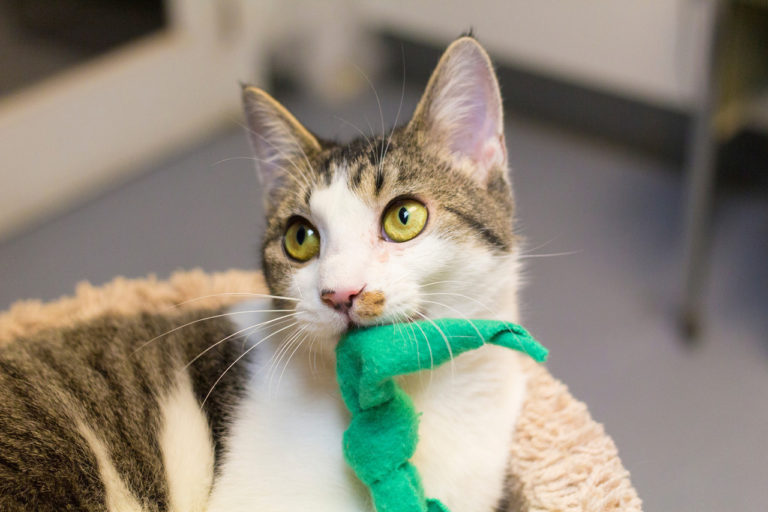It’s important to have realistic expectations when introducing a new pet to a resident pet. Some cats are more social than other cats. For example, an eight-year-old cat that has never been around other animals may never learn to share her territory (and her people) with other pets in the household. However, an eight-week-old kitten separated from her mom and littermates for the first time might prefer to have a cat or dog companion. Cats are territorial and need to be introduced to other animals very slowly in order to give them time to get use to each other before there is a face-to-face confrontation. Slow introductions help prevent fearful and aggressive problems from developing. PLEASE NOTE: When you introduce pets to each other, one of them may send “play” signals that can be misinterpreted by the other pet. If those signals are interpreted as aggression by one animal, then you should handle the situation as “aggressive.”
Cat to Cat Introductions
- Set up a separate room for your new cat with everything they need (food, water, litter, bed, toys, scratching post).
- NOTE: these time guidelines are a suggestion. Base moving forward on both cats’ behavior – when both cats seem comfortable and relaxed, move to the next step. Ere on the side of going slowly and building on success.
First 3 – 14 days (don’t do anything on day one and two, just keep them in separate rooms)
- Scent swap: Take a cloth and rub it against one cat’s cheeks, give it to the other cat and vice versa. Swap other items that smell like the other cat such as bedding. Keep swapping these items back-and-forth to establish “group scent.”
- Site swap: let each cat explore the other’s territory but don’t let them see each other yet.
- Feed meals and treats on either side of the door so that both cats start to associate each other with good things. If either cat will not eat or shows signs of stress or excitement, move them further from the door. Use extra-special treats and food for these meals.
- Move the bowls slowly closer to the door until they are right next to it. Move to step two when both cats are completely relaxed at this level.
Days 15 – 21
- Open the door and put up a baby gate. Drape a blanket over the gate and gradually raise each time to make the process more gradual if needed.
- Feed meals with a cat on each side of the gate.
- Continue to keep closed in separate rooms when not doing these supervised interactions.
Days 22 – 28
- At least once each day, bring the cats into a large room together that is not central to either cat’s territory in the main part of the house. The room should have plenty of hiding spots and escape routes for the cats. Feed treats or engage each cat in play separately. Do not force the cats to interact.
- Keep separated by a closed door when no one is home until both cats seem happy and relaxed about being together.
- If there is any indication of stress levels rising, or the cats start staring at each other or becoming agitated, interrupt and separate them (keep your energy calm and happy).
Ongoing
- Keep separated by a closed door when no one is home until both cats seem happy and relaxed about being together.
- Go back a step or two if needed–it’s better to go slowly and build a good foundation. A fight or negative interaction can be hard to recover from.
Check out this 11-minute video by Jackson Galaxy on how to introduce cats.
Cat to Dog Introductions
- Set up a separate room for your cat with everything they need (food, water, litter, bed, toys, scratching post). Later you’ll need a baby gate for this room. The ideal baby gate will have a small door for the cat to go through that the dog can’t fit through. Or, you can raise the gate off the floor by 5” so the cat can slip under, and the dog can’t follow.
- Provide high perching spots for your cat throughout the house. e.g, cat trees, shelves, boxes on the wall.
- NOTE: these time guidelines are a suggestion. Base moving forward on both pets’ behavior – when both seem comfortable and relaxed, move to the next step. If the cat is very stressed or the dog is showing intense interest, excitement, or stress, stay at that step for longer.
- Test some treats and find what are very “high value” for each pet. Hint: soft and stinky!
Days 3 – 5 (Give your cat at least 48 hours to settle, and only start this step when your cat is relaxed and comfortable in their room)
- When the dog is in the house, keep the cat in their room.
- When the dog is away from the house allow the cat to have free roam (be sure to put the cat back in their room before the dog re-enters the home!)
- Put extra bedding in the cat’s room then bring it into the dog’s space for them to sniff, and vice versa.
- Meals should be fed on either side of the door so that both pets associate each other with good things. If either pet will not eat or shows signs of stress or excitement, move them further from the door.
Days 6 – 14
- Once or twice a day, open the door and put a baby gate up (with no option for cat to go through/under it). Keep the dog on leash, allow the pets to see each other. Feed the dog treats. If calm, move to step 3. If not, continue with this step but try the gate every couple of days.
Days 15 – 30
- Allow the cat to come out of their room if they choose (do not take the dog into the cat’s room), hold your dog on leash, reward with treats, keep at a distance.
- Keep separate when unable to directly supervise.
Days 31 – 44
- When someone is home, have the cat’s room blocked with the baby gate (small door open), but allow them to free roam.
- Reward calm behavior.
- At least once a day, actively reward the dog with treats for calm behavior when the cat is present.
- Keep separated by a closed door when no one is home.
- If there is any indication of chasing or excitement, have the dog drag a leash so it’s easy to step on and interrupt (then use treats to reward calm behavior)
Ongoing
- Keep the baby gate in place for as long as needed—this could be months or longer. Having a safe place for the cat to retreat to is critical. Reward calm behavior. Go back a step or two if needed–it’s better to go slowly and build a good foundation.
Need help? Just ask! These tips are just scratching the surface when it comes to introducing pets and sometimes you need additional help. Our staff can offer advice and also recommend professional animal behaviorists depending on the issue you’re encountering with your own pets.

